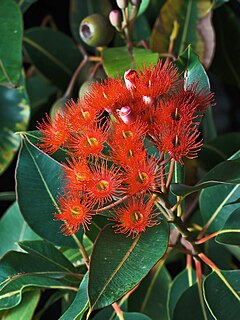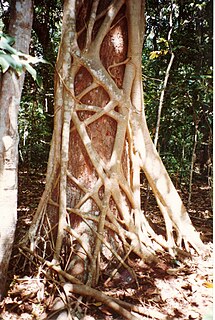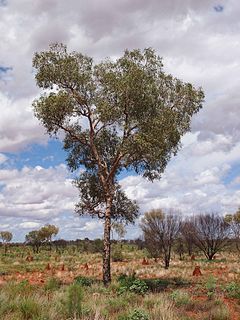
Corymbia ficifolia, commonly known as the red flowering gum, is a species of small tree that is endemic to the south-west of Western Australia. It has rough, fibrous bark on the trunk and branches, egg-shaped to broadly lance-shape adult leaves, flower buds in groups of seven, bright red, pink or orange flowers and urn-shaped fruit. It has a restricted distribution in the wild but is one of the most commonly planted ornamental eucalypts.

Ficus macrophylla, commonly known as the Moreton Bay fig or Australian banyan, is a large evergreen banyan tree of the family Moraceae native to eastern Australia, from the Wide Bay–Burnett region in the north to the Illawarra in New South Wales, as well as Lord Howe Island. Its common name is derived from Moreton Bay in Queensland, Australia. It is best known for its imposing buttress roots.

Persoonia longifolia, commonly known as snottygobble, is a species of flowering plant in the family Proteaceae and is endemic to the southwest of Western Australia. It is a shrub or small tree characterised by its weeping foliage, yellow flowers and distinctive flaky bark.

Corymbia polycarpa, also known as the long-fruited bloodwood or small-flowered bloodwood, is a species of tree that is endemic to northern Australia. Indigenous Australians of different language groups have different names for the tree. The Nungali peoples know the tree as narrga or gunjid, the Mulluk-Mulluk know it as dawart, the Yangman know it as bodog, the Gurindji peoples as jadburru and the Wagiman as jagatjjin. It is a medium-sized tree with rough, tessellated bark on the trunk and branches, lance-shaped to curved adult leaves, flower buds in groups of seven or nine, white or cream-coloured flowers and barrel-shaped fruit.

Ficus pleurocarpa, commonly known as the banana fig, karpe fig or gabi fig, is a fig that is endemic to the wet tropical rainforests of northeastern Queensland, Australia. It has characteristic ribbed orange and red cylindrical syconia. It begins life as a hemiepiphyte, later becoming a tree up to 25 m (82 ft) tall. F. pleurocarpa is one of the few figs known to be pollinated by more than one species of fig wasp.
Ficus crassipes, commonly known as the round-leaved banana fig is a fig that is endemic to the wet tropical rainforests of northeastern Queensland, Australia. It has large brownish cylindrical syconia.
Ficus triradiata, commonly known as the red stipule fig is a hemiepiphytic fig that is endemic to the wet tropical rainforests of northeastern Queensland, Australia.

Ficus watkinsiana, commonly known as strangler fig, Watkins' fig, nipple fig or the green-leaved Moreton Bay fig is a hemiepiphytic fig that is endemic to Australia. The species exists in three populations—one in northeast Queensland and the others in southeast Queensland and northeast New South Wales.
Ficus subpuberula is a lithophytic fig that is endemic to Australia. It ranges from extreme western Queensland, through the Northern Territory, into Western Australia.

Ficus platypoda, commonly known as the desert fig or rock fig, is a fig that is endemic to central and northern Australia. It is a lithophytic plant that grows on rocky outcrops, reaching 10 m in height.

Ficus obliqua, commonly known as the small-leaved fig, is a tree in the family Moraceae, native to eastern Australia, New Guinea, eastern Indonesia to Sulawesi and islands in the southwestern Pacific Ocean. Previously known for many years as Ficus eugenioides, it is a banyan of the genus Ficus, which contains around 750 species worldwide in warm climates, including the edible fig. Beginning life as a seedling, which grows on other plants (epiphyte) or on rocks (lithophyte), F. obliqua can grow to 60 m (200 ft) high and nearly as wide with a pale grey buttressed trunk, and glossy green leaves.

Corymbia opaca, also known as the desert bloodwood, is a species of tree that is endemic to northern Australia. It has rough bark on part or all of the trunk, lance-shaped leaves, club-shaped flower buds and urn-shaped fruit. Several parts of this plant are used by Aboriginal Australians in traditional medicine.

Eidothea zoexylocarya is a species of tall rainforest trees endemic to north-eastern Queensland, Australia and constituting part of the plant family Proteaceae. In European–Australian science, these trees were only recognised in recent decades, first from the slopes of Mount Bartle Frere, the Queensland mountain which reaches the highest altitude. In 1995, scientific descriptions of the trees, as this genus and type species, were published for the first time by Andrew W. Douglas and Bernie Hyland. The species name refers to the almost identical fossil fruit Xylocaryon lockiiF.Muell., from Ballarat, southern Australia, still extant in this north-eastern Australian species.

Corymbia henryi, commonly known as the large-leaved spotted gum, is a species of small to medium-sized tree that is endemic to north-eastern Australia. It has smooth, mottled bark, lance-shaped adult leaves, flower buds in groups of three, white or lemon yellow flowers and barrel-shaped to urn-shaped fruit.

Persoonia conjuncta is a species of flowering plant in the family Lamiaceae and is endemic to eastern New South Wales. It is an erect shrub or small tree with narrow elliptic to lance-shaped leaves, yellow, tube-shaped flowers in groups of up to sixteen and green fruit.

Persoonia filiformis is a species of flowering plant in the family Proteaceae and is endemic to the south-west of Western Australia. It is a small, erect shrub with hairy young branchlets, linear leaves and greenish yellow flowers borne singly or in groups of up to twenty on a rachis up to 30 mm (1.2 in) long.

Persoonia stricta is a species of flowering plant in the family Proteaceae and is endemic to the south-west of Western Australia. It is an erect, spreading shrub with smooth bark, linear to spatula-shaped or oblong leaves, and bright yellow flowers borne in groups of four to twenty-five on a rachis 3–100 mm (0.12–3.94 in) long, each flower with a leaf or scale leaf at its base.
Eucalyptus recta, commonly known as silver mallet, is a species of mallet or tree that is endemic to a small area in Western Australia. It has smooth silvery bark, lance-shaped adult leaves, flower buds in groups of nine or eleven, creamy white to pale yellow flowers and pendent, flattened spherical fruit.
Corymbia hamersleyana is a species of small tree or mallee that is endemic to the Pilbara region of Western Australia. It has rough, flaky bark on part or all of the trunk, smooth cream-coloured bark above, lance-shaped adult leaves, flowers buds in groups of seven or nine, creamy white flowers and urn-shaped fruit.
Eucalyptus dolichocera is a species of mallee that is endemic to Western Australia. It has rough, ribbony bark near the base, smooth grey to brownish above, lance-shaped adult leaves, flower buds arranged in groups of seven, yellow to cream-coloured flowers and cup-shaped or urn-shaped fruit.














